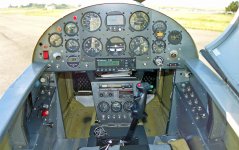Van's Air Force
You are using an out of date browser. It may not display this or other websites correctly.
You should upgrade or use an alternative browser.
You should upgrade or use an alternative browser.
The 3 o’clock rule
- Thread starter Rv6mike
- Start date
It’s a handy trick that some CFI’s use. In many airplanes the person in the right seat can’t see the numbers on the right side of a conventional airspeed indicator. In most of the airplanes I have instructed in (mostly Cessnas, Cherokees, and Bonanzas), this trick works as a pretty good estimate of the recommended speed on short final. I’d never trust it without verifying it first, however. I have wondered if there is or was an FAA certification rule about it, but I’ve not researched it. The “trick” is rapidly becoming obsolete in this age of glass instruments.
Majorpayne317641
Well Known Member
So what is the rule?It’s a handy trick that some CFI’s use. In many airplanes the person in the right seat can’t see the numbers on the right side of a conventional airspeed indicator. In most of the airplanes I have instructed in (mostly Cessnas, Cherokees, and Bonanzas), this trick works as a pretty good estimate of the recommended speed on short final. I’d never trust it without verifying it first, however. I have wondered if there is or was an FAA certification rule about it, but I’ve not researched it. The “trick” is rapidly becoming obsolete in this age of glass instruments.
On a conventional “steam gauge” airspeed indicator, when the needle is pointing to the 3 o’clock position, your IAS is approximately what the POH says it should be on short final. It’s handy to know because from the right seat, it’s often the case that the numbers on that area of the gauge can’t be seen because they are blocked by a “lip” around the gauge (or by some other obstruction), but the needle of the gauge — or at least its orientation — can be seen. But like I said, I don’t think it’s the case with every certified airplane. Verify it first!So what is the rule?
Hope that explanation is a little better!
What are these "conventional" or "steam gauge" indicators of which you speak? 
/s
/s
Roadjunkie1
Well Known Member
On SuzieQ that would be about 95 mph (~82kts) which would be where I might be on late downwind with one notch of flaps already out. So: a little (LOT) fast for a short final approach. Can you say FLOAT.....? I put my.....what was that called?........oh, yeah: steam gauge ASI on the left upper corner of the panel as most patterns are going to be left-hand and that will keep the ASI always in the line-of-sight. There are no lips or other obstructions of the ASI. I will include a panel of nearly nothing BUT steam gauges! Which I still really like, by the way! The Rocky Mountain instrument in the top center has been replaced by a Dynon 10A and the very ancient Trimble GPS is gone (high class at the time....), replaced by a portable iFly unit. I have no interest in more glass....except maybe a uAvionics AV-30........  Note the (also ancient).....um..........maps in the map pocket....made of folded paper......took 4 sectionals (some might have to Google that
Note the (also ancient).....um..........maps in the map pocket....made of folded paper......took 4 sectionals (some might have to Google that ) to get to OSH........knee pad on my left thigh, map clip/holder on my right thigh.........ah, those were the days.........
) to get to OSH........knee pad on my left thigh, map clip/holder on my right thigh.........ah, those were the days.........
Attachments
I think it is a great idea if the designers thought things through well enough that all the needles are siting at a specific position (three O‘clock) for a specific flight configuration….but I’d never make the assumption that such is the case for all airplanes - or any airplane other than ones that are documented to be that way. I have flown a huge different number of machine’s and wouldn’t dare generalize on something that is safety-related like approach or stall speeds.
Desert Rat
Well Known Member
this idea seems loosely related to the general idea I learned when I was working with industrial pumping systems, that system gauging (such as analog pressure gauges) should be specified so that the expected normal working pressure is at approx the 50% point of the gauge's indicating range
It's a great rule of thumb and yeah, it would be great if something like that was increased to the level of standardization.
Checking all the engine gauges at the start of the takeoff roll... we all look for "in the green" or whatever. Yeah, seems like that could be even better if all the gauges could be ranged and positioned to point in a given direction...12:00, 3:00, or whatever....
and this is one reason I tend to prefer analog gauges generally....
It's a great rule of thumb and yeah, it would be great if something like that was increased to the level of standardization.
Checking all the engine gauges at the start of the takeoff roll... we all look for "in the green" or whatever. Yeah, seems like that could be even better if all the gauges could be ranged and positioned to point in a given direction...12:00, 3:00, or whatever....
and this is one reason I tend to prefer analog gauges generally....






